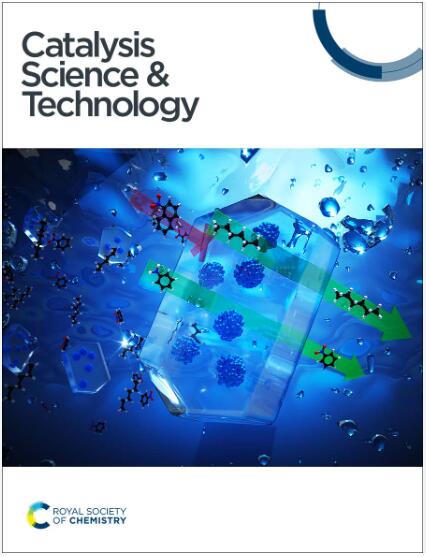设计一种基于rh的非均相乙烯氢甲酰化双金属催化剂:结合理论预测和实验筛选
IF 4.2
3区 化学
Q2 CHEMISTRY, PHYSICAL
引用次数: 0
摘要
介绍了一种rh基双金属乙烯氢甲酰化催化剂的设计方法。在后期三维过渡金属(Fe, Co, Ni, Cu和Zn)中,使用相图评估了与Rh合金的热力学可行性,排除了Cu的考虑。采用H2程序升温还原法(H2- tpr)考察了氧化前驱体与Rh形成合金的还原性,进一步排除了Fe和Zn。采用密度泛函理论(DFT)计算选择催化性能描述符,表明CO吸附能越低,氢甲酰化活性越强;CO和H吸附能差越大,对醛和醇的选择性越强(氧选择性),表明CO是比Ni更好的合金元素。结果表明,成功合成了一种RhCo双金属催化剂,该催化剂在乙烯氢甲酰化反应中氧收率最高,选择性优于单金属Rh催化剂。本文章由计算机程序翻译,如有差异,请以英文原文为准。

Designing a Rh-based bimetallic catalyst for heterogeneous ethylene hydroformylation: combining theoretical predictions and experimental screening†
An approach to the design of a Rh-based bimetallic catalyst for ethylene hydroformylation was introduced. Among late 3d transition metals (Fe, Co, Ni, Cu and Zn), the thermodynamic feasibility of alloying with Rh was evaluated using phase diagrams, with Cu excluded from consideration. The reducibility of the oxide precursor to form an alloy with Rh was examined by H2 temperature-programmed reduction (H2-TPR), further excluding Fe and Zn from the potential alloying elements. Density functional theory (DFT) calculations were employed to select descriptors for catalytic performance, suggesting that a lower CO adsorption energy would enhance hydroformylation activity, and a larger difference between CO and H adsorption energies would promote selectivity to aldehydes and alcohols (oxy selectivity), suggesting that Co would be a better alloying element than Ni. As predicted, a RhCo bimetallic catalyst was successfully synthesized, which showed the highest oxy yield in ethylene hydroformylation among all the bimetallic catalysts, with a superior selectivity compared to that of a monometallic Rh catalyst.
求助全文
通过发布文献求助,成功后即可免费获取论文全文。
去求助
来源期刊

Catalysis Science & Technology
CHEMISTRY, PHYSICAL-
CiteScore
8.70
自引率
6.00%
发文量
587
审稿时长
1.5 months
期刊介绍:
A multidisciplinary journal focusing on cutting edge research across all fundamental science and technological aspects of catalysis.
Editor-in-chief: Bert Weckhuysen
Impact factor: 5.0
Time to first decision (peer reviewed only): 31 days
 求助内容:
求助内容: 应助结果提醒方式:
应助结果提醒方式:


